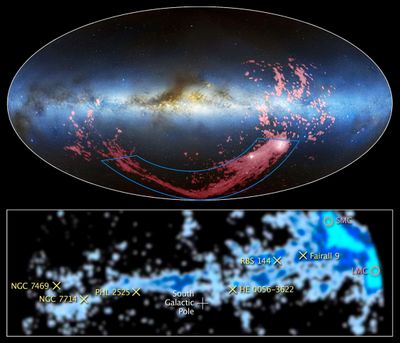
These companion images show wide and close-up views of a long ribbon of gas called the Magellanic Stream, which stretches nearly halfway around our Milky Way galaxy.
In the combined radio and visible-light image at top, the gaseous stream is shown in pink. The radio observations, taken from the Leiden-Argentine-Bonn (LAB) Survey, have been combined with visible-light views from the Mellinger All-Sky Panorama. The Milky Way is the light blue band in the center of the image. The brown clumps are interstellar dust clouds in our galaxy. The Magellanic Clouds, satellite galaxies of the Milky Way, are the white regions at bottom right.
The image at bottom, taken at radio wavelengths, is a close-up map of the Magellanic Stream that also was generated from the LAB Survey. Researchers determined the chemistry of the gas filament by using Hubble's Cosmic Origins Spectrograph (COS) to measure the amount of heavy elements, such as oxygen and sulfur, at six locations (marked with an "x") along the Magellanic Stream. COS observed faraway quasars whose emitted light passes through the stream and detected the spectral fingerprints of these elements from the way they absorb ultraviolet light. Quasars are the brilliant cores of active galaxies.
The astronomers found a low amount of oxygen and sulfur along most of the stream. This matches the levels in the Small Magellanic Cloud (SMC) about 2 billion years ago, when the gaseous ribbon was thought to have been formed. As the SMC plows though the galactic halo, its gas is torn out via processes called ram-pressure and tidal stripping. The observation identifies the SMC as the primary source of lost gas in the stream.
The team, however, also discovered a much higher level of sulfur in a region closer to the Magellanic Clouds. This measurement corresponds to the current amount of heavier elements in the Large Magellanic Cloud (LMC). The observations offer evidence that the LMC also has contributed material to the stream. The pink circles at right mark the location of the Small and Large Magellanic Clouds.
See the webside for more details: http://hubblesite.org/newscenter/archive/releases/2013/27/image/a/ (SY)